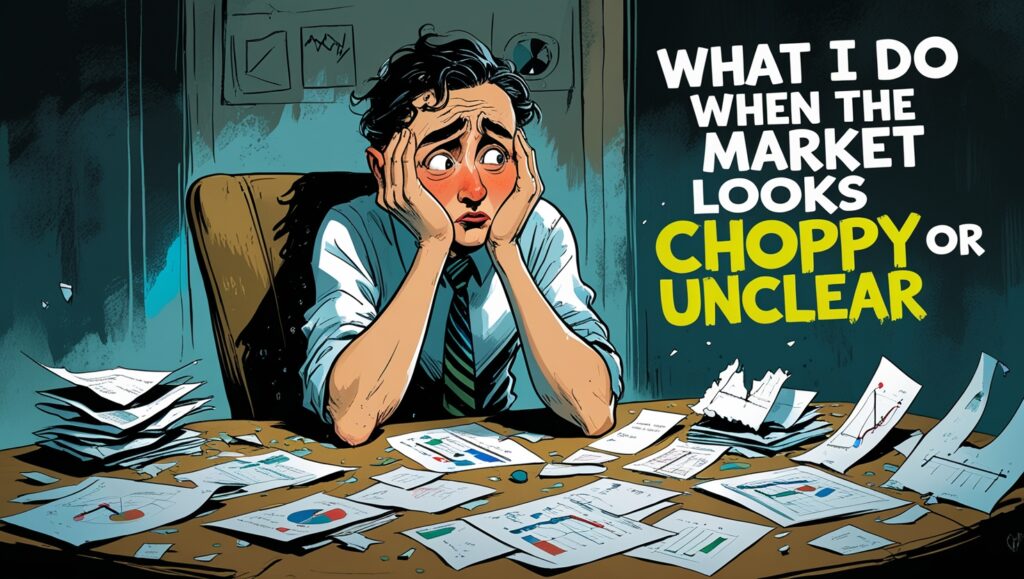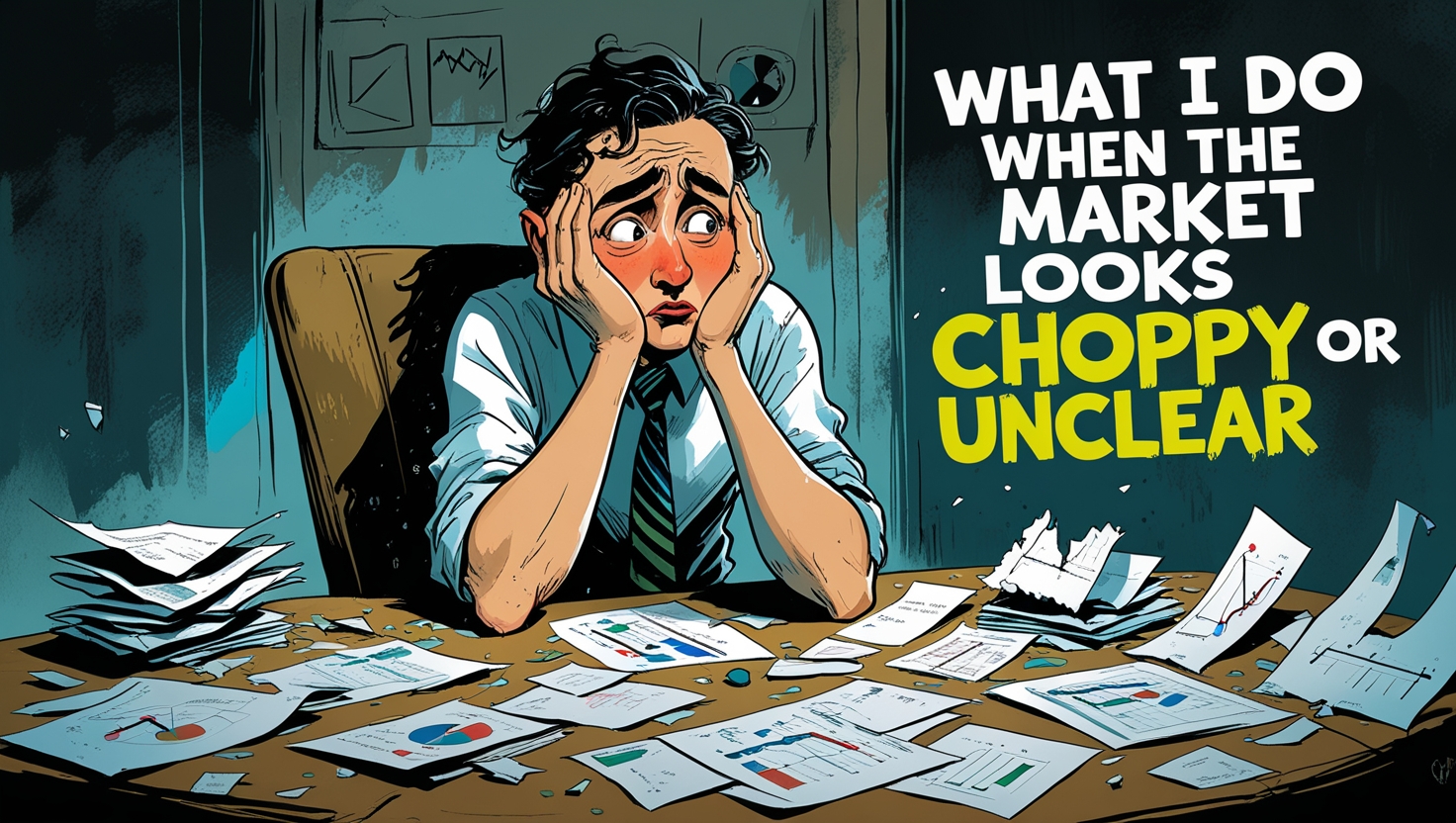What I Do When the Market Looks Choppy or Unclear
What I Do When the Market Looks Choppy or Unclear
Why I Don’t Force Trades in a Choppy Market
Let me be honest — one of the biggest mistakes I used to make was trying to force trades on days when the market gave no clear direction. I’d stare at my screen, see indecision candles, low volume, or weird gaps, and still try to trade. What did I get? Losses. Frustration. Doubt.
Now, when the market looks choppy or unclear, I do the exact opposite: I slow down, zoom out, and follow a plan that protects both my money and my mind.

Table of Contents
My 3-Step Plan for Choppy Days
Over time, I developed a simple method that helps me stay disciplined when the market is messy:
1. Zoom Out to the Bigger Picture
I start by checking the daily and hourly charts. If everything looks sideways, overlapping, or lacking momentum, I take it as a yellow light. No need to speed through noise. I might still trade — but only if something clean stands out.
2. Lower My Share Size
If I still want to test a setup on a choppy day, I reduce my position size. That way, I can stay engaged without risking real damage. If the setup fails, I’m emotionally fine. If it works, great — I still followed my rules.
3. Revisit My Watchlist, But Don’t Chase
I keep my watchlist limited to 6 stocks max, all handpicked before 9:30AM. On unclear days, I’ll glance at them every 15–30 minutes. If nothing develops, I walk away. That’s it. No forcing alerts, no overtrading.
What I Do Instead of Trading
You might think stepping away is wasted time. For me, it’s the opposite. Here’s what I do when I choose not to trade:
- Review past trades from my tracker
- Watch 1–2 quality chart recaps on YouTube
- Update my personal journal with thoughts about market behavior
- Refine my entry checklist or backtest setups
- Or simply take the day off and come back with fresh eyes
I treat it like a professional would — some days are for offense, some are for defense.
Why This Keeps Me Profitable
When I stopped forcing trades during choppy sessions, my win rate increased. My stress levels dropped. And ironically, I made more money by doing less.
Avoiding low-probability days is just as important as knowing when to push. If you’ve ever overtraded out of boredom or revenge, this strategy will change everything.
Want My Exact Checklist?
I share the full routine I use each morning to prep, filter noise, and find stocks that actually move — all inside my ebook:
👉 “How I Pay My Bills With Simple Stock Setups”
It includes:
- My daily prep flow (even if the market is slow)
- My watchlist creation system
- The setups I trust when things are clean — and what I do when they’re not
It’s built for people with small accounts, limited time, and no interest in 10 indicators cluttering their screen.
Final Thought
The market isn’t always clear — but your discipline can be. If you can learn to sit out the chop, avoid the noise, and wait for clean setups, you’re already ahead of 90% of traders out there.
Want to keep it simple and grow steadily? Stick with me.
Let the confused traders burn out. We trade smart — or not at all.
1. I Treat Flat Days Like Research Days
Not every trading day is for execution. When I sense the market is flat or sluggish, I flip my mindset — it becomes a research day, not a trading day. That mindset shift alone takes pressure off and turns wasted screen time into growth time.
2. I Review My Trading Journal
I go back through past trades — both wins and losses. I look for patterns in behavior: What triggered my losses on uncertain days? When did I hesitate too much or act too fast? This reflection has helped me improve more than any trading course ever could.
3. I Watch What Smart Money Is Doing
Even if I’m not trading, I keep an eye on volume spikes and institutional interest. Are certain stocks seeing unusual activity? Is there an ETF with divergence? These clues help me prep for tomorrow, even if I take no action today.
4. I Avoid Discords and Alerts on Choppy Days
On unclear days, alerts are the worst distraction. Everyone’s guessing, and it’s tempting to follow someone into a random play. But that’s how I used to burn accounts fast. Now, I trust my prep — or I don’t trade at all.
5. I Stay Grateful I Didn’t Force It
Every time I skip a choppy market day and later check the charts — and I see a mess — I smile. That’s money saved, not opportunity missed. Skipping bad setups is part of real growth as a trader.
6. I Add Notes to My Watchlist
Even if I don’t trade, I’ll update my watchlist with new notes like “choppy open,” “fake breakout,” or “flat volume.” These help me track stock behavior over time, not just minute-to-minute.
7. I Practice Patience as a Skill
Some traders think patience is passive. It’s not. Patience is active discipline. Choosing not to act, even when you’re itching to trade, is a muscle you build — and it pays off when the real move shows up.
8. I Remind Myself of My Edge
My edge isn’t trading all the time. It’s trading with clarity. When the market is unclear, my edge is in waiting for clarity. That simple belief has saved me thousands in losses.
9. I Don’t Let Boredom Be Expensive
Trading out of boredom is one of the fastest ways to lose money. So I fill my time with productive alternatives like writing watchlist breakdowns or studying new sectors. I refuse to let boredom become an expensive habit.
10. I Work On My Exit Strategy
If there’s no good entry today, I’ll refine my exit strategy. I’ll go over old trades and ask: Did I exit too early? Too late? How can I adjust my profit targets or stop-losses based on today’s market behavior?
11. I Take Advantage of the Mental Break
If I can’t trade clearly, I walk away guilt-free. This job is mental. Preserving my focus and clarity is just as important as my account balance. Sometimes, a walk, gym session, or journaling session is the best trade of the day.
12. I Use the Time to Educate
Choppy days give me margin to consume deeper content — a good trading book, a YouTube breakdown from a trader I respect, or even re-reading parts of my own ebook to reinforce my method. Education doesn’t stop just because the market is dull.

Stay ahead in the stock market! Subscribe to our newsletter and receive exclusive stock flow reports, trading insights, and actionable tips directly in your inbox. Join thousands of traders who get our updates first.







